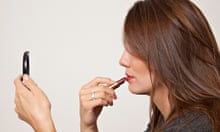Holly
For those who haven't heard of Tinder, let me introduce you. It's an app you can download at the click of an iPhone and play at the bus stop, one that uses your smartphone's GPS to track down other Tindering singles in your area. It's a game in which you quickly rate faces as hot or not, with a swipe of your finger to either the right or the left respectively. It's free, easy and convenient, and the prize you get at the end of it? A real-life date, with a real-life person.
Tinder is a strange phenomenon, yet also a natural evolution of what the dating scene for the millennial generation already looks like. This once stigma-ridden world has been completely revived in the past five years, becoming more the bastion of busy twentysomethings in demanding urban jobs than that of their divorced middle-aged parents. Where once it was assumed that the person advertising themselves awkwardly on a screen was there because of social ineptitude, it's now much more common – and accurate – to assume that they are instead working 13-hour days in order to convert their unpaid internship into an underpaid graduate job. Time to cruise the bars, you say? Time to loiter in bookshops and catch a nice boy's eye over a copy of Patti Smith's autobiography? Not so, my friend! Where once there were pub japes, there are now spreadsheets. Where once there were chat-up lines and prospective girlfriends, there is now the Thursday dinner meeting with a prospective boss.
In some ways it's surprising that an innovation like Tinder happened, given that the app was developed in a start-up lab funded by IAC/InterActiveCorp, the American company that also owns the phenomenally successful sites match.com and OkCupid. Why fix what isn't broken? Recent statistics told entrepreneurs that an ever-expanding number of people are entering those websites through their smartphones – that lives are increasingly being lived on the go. Additionally, market research showed the existence of the younger demographic – mostly driven people at the dawn of their careers, looking for casual forays into dating and one-night stands. In the US, where Tinder launched last September, it is now the fastest-growing free dating app. In the UK, users are increasing by 25% every week. Where match.com might be the quality bottle of red, Tinder is the alcopop: addictively simple, childishly appealing and deliberately youthful. It even comes with an age limit of 50.
Tinder uses the same GPS capabilities as Grindr – the wildly popular and barefacedly grimy gay hook-up app – but requires every user to have a Facebook account, which gives it a safer air. People are less likely to create multiple accounts, and users can't contact their potential beaux until both have said "yes" to one another on screen. This is another way in which the app improves upon the dating website experience, where women are often inundated with sexual commentary from unwanted suitors.

A quick scan of the local area gives me a seemingly endless list of men to choose from, all in the age range I've specified in the "preferences" section (admittedly, I live in central London, and the pickings would be slimmer if I were Tindering from the Yorkshire dales). I flick idly through a few pictures, subjecting them to either the heart icon or the big red X. I'm careful not to use it in the office: friends of mine have already come a cropper by discovering their colleagues on the screen and finding out more than they ever wanted to know – a picture of the IT coordinator's penis is never welcome. Tinder is quite strict about vetting that kind of image, but inevitably a few slip through.
Every so often, I'm informed that I've approved someone who has also approved me. "It's a match!" the screen announces, and a chat box appears, inviting me to start up a text conversation with a stranger who has declared me attractive enough to parley with. In the US, there are apparently more than 2m matches every day. It feels uncomfortably shallow at first but, as one of my fellow Tindering friends points out, "You'd just be doing it in your head at the pub anyway."
"Don't just say hi," a few men's profiles warn women who might dare to chat with them. "You may be Daddy's little girl at home, but on here you're going to have to impress me," says one particularly distasteful one. I am hit-and-miss with my openers – I start off using the standing-at-a-bar approach ("How are you?") and quickly realise this won't pique anyone's interest enough for them to take time out of their superfast scrolling to reply. Eventually, I settle on personal but innocuous statements ("Cool hair", "Good to see you like Tom Waits, too", "I also enjoy doing the supermarket shop in an animal onesie"). These produce a few interesting conversations among tens of deadly dull ones – "where u go out?" followed up with "u go out much?" and "u drink lots?" killed my exchange with a handsome Irishman. One man who cheekily asks if I'm "up for a shag" at 3pm (to which I reply "Not now, I'm working" and get the midnight sequel "How about now?") makes me laugh out loud. But most are quick to arrange dates, and I'm happy with that: the platform doesn't exactly lend itself to nuanced dialogue.
A Tinder date is much like one that you might have arranged on a more conventional dating website, with two exceptions: you have probably shared only a sentence or two with one another, and you have no way of ascertaining the other person's height. The height factor genuinely stumps me, as there's no polite way of asking, although I do learn pretty quickly that most tall male Tinderers will advertise it faux-subtly on their page ("Hey, just saying, I'm 6ft 3in and I love Bob Dylan"). Nevertheless, my first date is a lot shorter than I imagined. Even more disconcertingly, he talks like a dating profile ("So why did you move to London?" I ask; "Curiosity," he replies, before trying to kiss me) and it turns out we have very little in common. The second is much the same, except taller, and the third barely speaks a word of English, which makes for an extremely awkward half-hour before I make my excuses and leave.
The fourth and fifth excursions are a little more charmed. Number four is an investment banker (alarm bells) but has great taste in music, and when he takes me to an unpretentious bar I never knew existed near my house and tells me about his childhood, I start to forgive him his job title. "I would never usually use anything like Tinder," he says, the same way that most men attempt to when you turn up to meet them. Curiously my female friends are much less inclined to be apologetic, and explain their presence on the dating app simply with the phrase: "It's normal now." Against all odds, the investment banker and I end up arranging a second date for next week.
Number five takes me to a subtitled movie at the Barbican, the Viagra of all hipster dates. We get lost on our way out and end up standing in the darkness, trapped by a maze of brutalist architecture and a large moat, laughing at our inability to navigate one of the most iconic structures in London. I'm just about to convince myself that I'm falling in love with him.
"We could swim across," I say, gesturing towards the moat and accompanying fountains. "If this was Garden State, that's totally what would happen."
"Come on now," he says, laughing. "I'm no Zach Braff, and you're no Natalie Portman."
This true but unnecessary slight floors me, and on the walk home from the tube I block his chat box. It turns out that the dating world is just as cruel as it ever was, with just as much chance of toying with your emotions, whether you match the savvy, carefree Tinder demographic or not. But there's no doubting that the app takes some of the sting out of "putting yourself out there": you quickly forget about the reams of people you've approved and who haven't approved you back, thus sparing yourself all the emotional turmoil you might have encountered by approaching an uninterested person in the real world. Eventually, however, Tinder exhausts even the most hardened cynic's capacity for superficiality.
A day later, I'm walking back from work towards my house when three young men on bikes follow me down a side street and snatch my iPhone out of my hand. I can't help but feel a modicum of relief.
Pete

A brief history of internet dating and my relationship with it. In the 1990s, in the days of dial-up, strange websites with names like Love and Friends, websites designed specifically to help you meet members of the opposite sex, began to appear. I joined them. Over time, this first wave of dating sites began to be subsumed and crushed by the behemoths: Udate, match.com, datingdirect.com, offering simple functionality, instant messaging features and lots of room for photographs. I joined them, too. Inevitably, entrepreneurs started to realise that there were people out there who were interested only in having sex, and sites such as AdultFriendFinder offered users the unique experience of deciding whether or not they would like to sleep with a person based solely on pictures of their genitals. I did not join them.
After years of on-and-off e-dating, in which I've met 150-200 women, fallen in love with one and invented extravagant excuses to extricate myself from awkward encounters with countless others, you might think I'd be tired of it all. And you'd be right. I'm exhausted. Yet the latest innovations, the first app-specific ones, Twine and Tinder, have thrown up new possibilities. They are the yin to each other's yang. Twine, suggesting the slow process of binding, offers just that – its USP is you get to know people via the exchange of messages and reveal your profile photo only when you both feel you have connected personality-wise. Tinder is the spark of immediate heat, in which your phone tracks down singletons in your vague area, and gives you the simple option of noting whether or not you find them fanciable. If you do them, and they do you, then you can start talking and, presumably, arranging illicit trysts. Or coffee.
With Twine, I came within a couple of days of meeting up with one of the – apparently extremely few – people who are giving it a go, before she got fed up with the painful functionality of the app and decided that it wasn't for her. And she had a very good point, because Twine is interminable. It tries to maintain a near-perfect ratio of men to women which, as any dating website will tell you, is never going to happen, thanks to the inherent desperation of men. After a lengthy signing-up process, I was still unable to view any profiles because there were "462 more men than women in my area" but I could "jump the queue" by suggesting to my female Facebook friends that they join. Only then would I be invited into the inner sanctum. Once I had harangued a friend into joining, each "twine" (message) took about a minute to load. Worse, it turned out the person I was sending anonymous banter to was a man. Perhaps it wasn't surprising; I later logged on and found out there were no women between the ages of 29 and 45 local to my postcode. Instead the load-screen offered up the phrase "Establishing cross-system neural links", which sounds like the kind of thing the on-board computers say in Pacific Rim.
Of the two apps, though, Tinder sounded worse, just because it seemed so contemptuously superficial. There are hundreds upon thousands of women, about whom you know almost nothing, and you snap-appraise them with a single swipe. It's a finger-flicking hymn to the instant gratification of the smartphone age. It's addictive.
At first, the sheer deluge of random faces, selfies, girls kissing other girls (is that a thing nowadays?) and girls wearing cat face paint (apparently that is) was bewildering and meaningless. I rejected, I accepted, I rejected some more, a couple of people responded. I started to feel like the evil sheikh from Taken, picking out women: "I'll take that one… that one… and those two!" Or maybe I was getting annoyed that nobody was really liking me back.
Then I discovered that, as Tinder had synced with my Facebook profile, it had made my main picture a flyer from a battle rap event at which I'd performed. The ladies weren't seeing my face. So I changed it to one of me dressed in a pair of pink foam rubber buttocks. All of a sudden, the people I was favouriting were returning the favour. All because of foam buttocks.
Eleven days after I joined, I had my first Tinder date, in a once-fashionable pub. And it was really good. Three days later, we had a second one, and then another one the next day for good measure. I am calling her Anna, as she has begged for anonymity. Anna is great. We spent most of our first date laughing, our second in a kebab house (it was a lot more romantic than it sounds) and our third watching damp fireworks. That night I asked her what she was even doing on Tinder.
"Apart from the simplicity and time-consuming fun of Tinder, the feeling of exposure for a woman is a lot less than putting yourself on a dating website," she said. "And I always found that, in the main, what men were writing on their profiles was 90% bullshit, to the point that you may as well disregard it. You can tell just as much about a person from their choice of picture. And you were dressed as an arse in yours. What's not to like?"
One day, someone may find a way to combine the laudable old-school romantic ideals of Twine with the fast-food menu feel of Tinder, but at the moment Tinder is winning hands down. I imagined that nobody would ever meet anybody they cared about through something so shallow. It seemed absurd. Now I'm wondering if it's the absurdity of it that's part of the appeal, throwing together people who have a keen sense of the ridiculousness of what they are doing.
Something for me to think about as I prepare for Friday, when I am meeting Anna's mates.
The golden rules of tinder

1 No photos of weddings or babies in your profile – especially if either is yours
One surprised Tinderer was flicking through photos of a dapper-looking man when she discovered that the reason he'd scrubbed up so well was that they were taken at his wedding. There are only two possibilities here: horrendous cad, or horrendous baggage. Similarly, only the worst babysitter in the world uses the image of an angelic toddler to bolster his dating chances.
2 Resist the urge to make your first picture just your torso
It might seem sexy at the time, and you may well be proud of the spoils from your summer-long workout, but coming across a headless pic is creepy, and looks more like a serial killer's Polaroid collection than a tempting romantic opportunity.
3 Don't send more than two messages without a reply
If they haven't messaged you back, chances are that they've decided they don't fancy you any more, or their friend drunkenly swiped your face for a joke. Dust yourself off and get back on the horse.
4 Don't Tinder-chat for more than a week
This is the point at which it gets weird. You've bantered, you've worked out what each other does for a living, you've ascertained their level of literacy… Now go on a date – otherwise you've just got a pen pal.
5 Don't act ashamed
Tinder has already passed the social acceptability test: groups of friends debate faces in the pub, flatmates sit around Tindering together over the weekly group meal. There's no need to act as though you've been reduced to scraping the dating barrel, so don't include slightly ashamed assurances in your profile, such as: "We'll say we met at a party." Similarly, don't echo the sentiment on a date. Either Tinder wholeheartedly, or not at all.











Comments (…)
Sign in or create your Guardian account to join the discussion